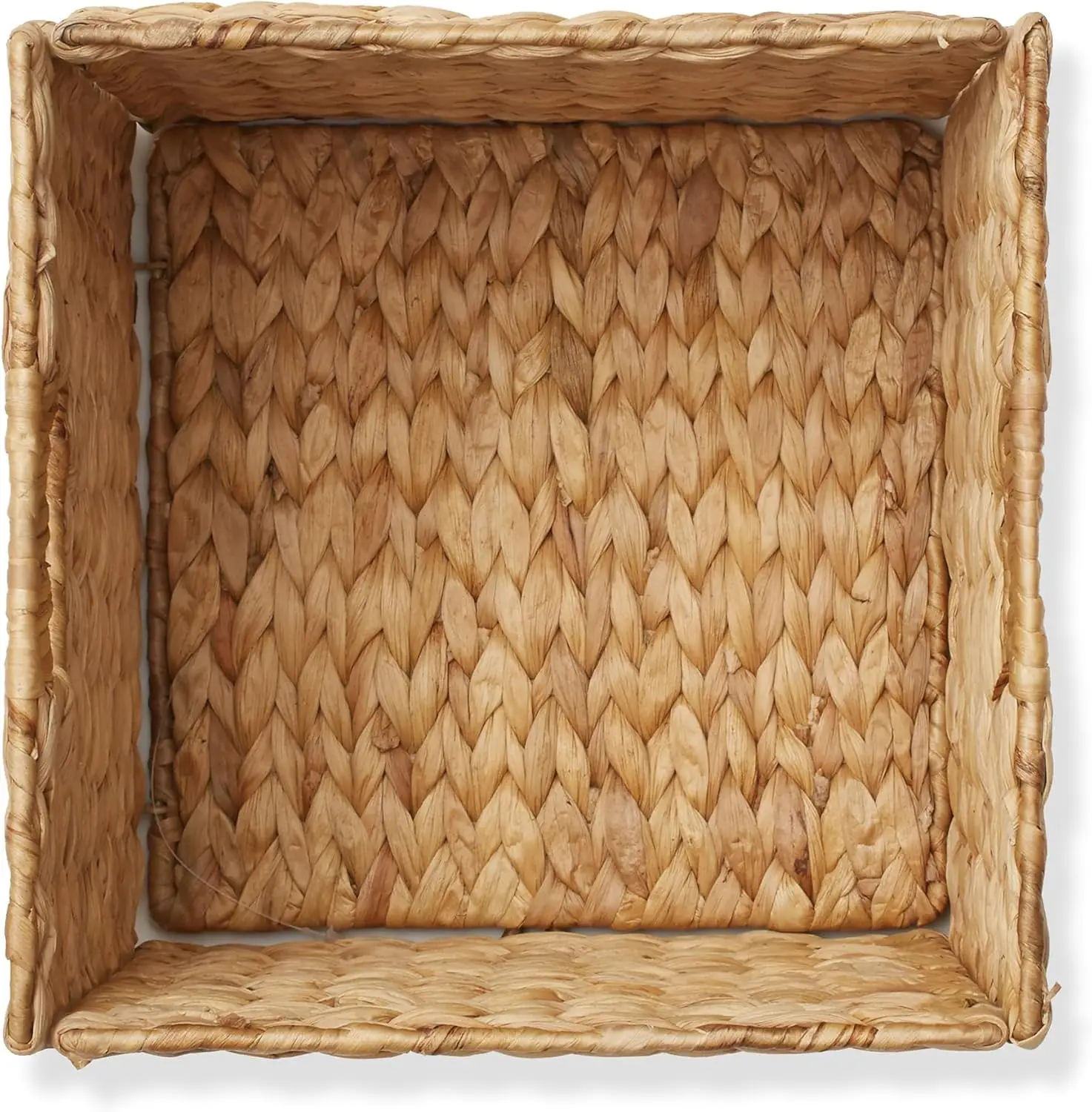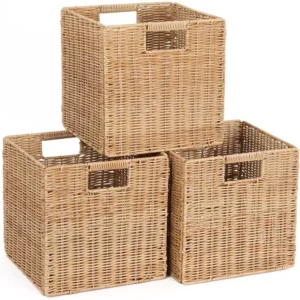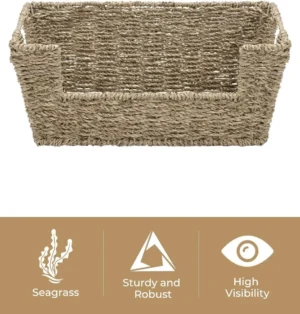Understanding Why Proper Basket Care Matters
Your beautiful woven baskets are more than just storage solutions—they’re often investments in both functionality and home décor. With proper care, these versatile pieces can last for decades rather than just a few years. Taking time to maintain your wicker baskets properly can make the difference between a family heirloom and a disposable item.
Proper basket maintenance offers several important benefits:
- Extended lifespan – Regular care can double or triple the useful life of your baskets
- Preserved beauty – Prevents fading, discoloration, and structural deterioration
- Maintained value – Particularly important for collectible or antique pieces
- Continued functionality – Prevents weakening that leads to basket failure
Without proper maintenance, baskets commonly develop mold growth, attract pests, become brittle, warp out of shape, or develop unpleasant odors. These issues not only affect appearance but can render baskets completely unusable.
Consider that some of the most beautiful antique baskets in museums today have survived hundreds of years through careful preservation. Your own baskets, with proper attention, could become treasured items passed down through generations, carrying both practical value and family history.
Know Your Basket: Material Identification Guide
Before you can properly care for your baskets, you need to understand what they’re made from. Many people mistakenly believe “wicker” is a material, when it actually refers to the weaving technique used to create the basket. The actual materials can vary widely, each requiring different care approaches.
Natural Materials
Rattan
Rattan is harvested from palm-like climbing plants native to tropical regions. Its distinctive characteristics include:
– Flexible yet strong structure
– Glossy, smooth appearance
– Visible wood grain pattern
– Natural light tan or honey color
Rattan baskets require specific care to maintain their flexibility and prevent cracking.
Bamboo
Bamboo baskets are created from this fast-growing grass:
– Features distinctive nodes or joints
– Generally has a smooth, hard surface
– Often used in cylindrical or flat strip form
– Typically lighter in color than rattan
Willow
Willow is prized for its flexibility and durability:
– Often grayish-brown in color
– May retain visible bark
– Very pliable when freshly harvested
– Creates tight, sturdy weaves
Reed
Reed is typically made from the inner pith core of rattan:
– Has a matte rather than glossy finish
– Highly absorbent and responsive to moisture
– Often used for intricate weaving patterns
– Generally lighter in color and weight
Seagrass
Seagrass offers a textural quality to baskets:
– Twisted, rope-like appearance
– Natural variations in color and thickness
– Slightly rigid feel with less flexibility than rattan
– Often has a distinctive grassy smell when new
Jute and Other Grasses
These materials create rustic, textural baskets:
– Rough texture with visible natural fibers
– Typically tan to brown coloration
– May shed small fibers over time
– Often used for more casual basket styles
Bark and Roots
These traditional materials create distinctive baskets:
– Often darker in coloration
– Feature unique natural patterns
– Typically more rigid than other materials
– May have irregular textures and shapes
Synthetic Materials
Modern baskets often incorporate synthetic materials that mimic the look of natural fibers:
– Resin/Plastic Wicker: Durable, weather-resistant, uniform in color
– Vinyl: Flexible, often used to coat natural materials for water resistance
– Synthetic Fibers: Engineered to mimic specific natural materials with enhanced durability
The differences between natural wicker vs synthetic options significantly impact how you’ll care for your baskets. Natural materials require more careful moisture control, while synthetic materials can generally withstand more aggressive cleaning.
Material Identification Table
| Material | Appearance | Texture | Flexibility | Care Difficulty |
|---|---|---|---|---|
| Rattan | Wood-like grain, glossy | Smooth | High | Moderate |
| Bamboo | Visible nodes, cylindrical | Hard, smooth | Low | Easy |
| Willow | Thin branches, sometimes with bark | Slightly rough | High when fresh | Moderate |
| Reed | Uniform thickness, pale | Matte, porous | Moderate | Higher |
| Seagrass | Twisted, rope-like | Textured | Low to moderate | Higher |
| Synthetic | Uniform color and pattern | Consistent | Variable | Easy |
Essential Tools and Supplies for Basket Maintenance
Proper basket care doesn’t require expensive specialized equipment. Most of what you need is likely already in your home. Having these items ready will make regular maintenance simpler and more effective.
Cleaning Tools
- Soft-bristle brushes: Small paintbrushes or makeup brushes work well for getting into tight weaves
- Vacuum cleaner with brush attachment: Perfect for removing dust without abrasion
- Microfiber cloths: Ideal for wiping down surfaces without scratching
- Cotton swabs: Helpful for reaching difficult corners and tight spaces
- Soft toothbrushes: Excellent for gentle scrubbing of small areas
Cleaning Solutions
- Mild dish soap: A few drops in water creates a gentle cleaning solution
- White vinegar: Effective for removing odors and addressing mild mildew
- Baking soda: Useful for absorbing odors and creating gentle scrubbing pastes
- Hydrogen peroxide: For treating mold spots on white or light-colored baskets
- Lemon juice: Natural brightener for light-colored natural fibers
Application Tools
- Spray bottles: For applying diluted cleaning solutions evenly
- Small bowls: For mixing cleaning solutions
- Protective gloves: To protect both hands and basket materials
- Eyedroppers: For precise application of cleaning solutions
- Clean sponges: For gentle application of cleaning solutions
Storage Supplies
- Acid-free tissue paper: For supporting basket shapes during storage
- Basket liners: Cloth or food-safe plastic to protect basket interiors
- Cotton dust covers: For protecting displayed baskets from dust
- Clear plastic storage bins: For storing seasonal baskets
When organizing laundry, wicker baskets need specific maintenance tools to address lint buildup and moisture exposure.
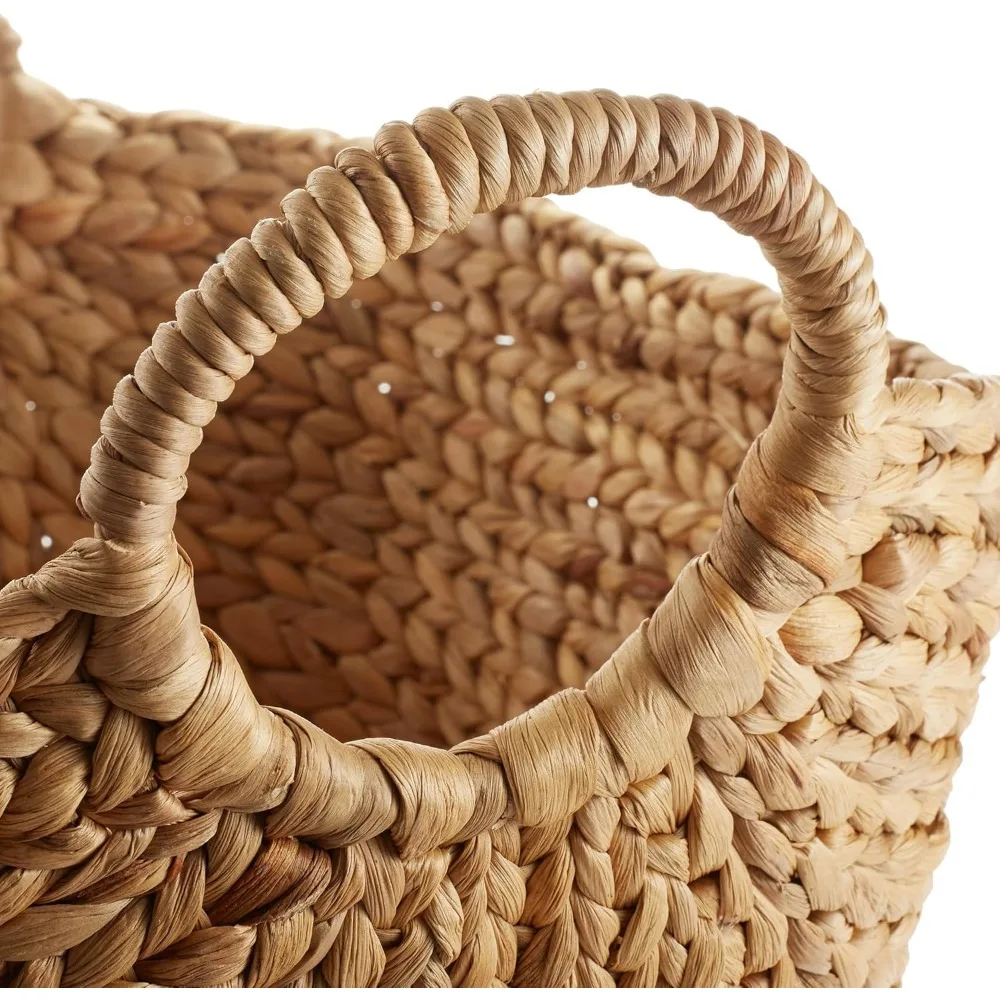
Foundational Care: Universal Principles for All Baskets
Regardless of what your baskets are made from or how you use them, certain care principles apply universally. These fundamentals will help preserve any basket’s structure, appearance, and functionality.
Gentle Handling Techniques
How you handle your baskets can significantly impact their longevity:
- Always support the basket’s base when lifting, especially when filled
- Avoid lifting by rims or handles on older or fragile baskets
- Handle with clean hands to prevent oil transfer that attracts dirt
- Don’t overload baskets beyond their weight capacity
- Place and remove items gently rather than dropping them in
Ideal Environmental Conditions
Your basket’s surroundings play a crucial role in their preservation:
- Store in cool, dry, well-ventilated areas
- Keep away from direct sunlight which causes fading and brittleness
- Maintain distance from heat sources like fireplaces, radiators, and heating vents
- Aim for moderate humidity (40-65% relative humidity) for plant-based materials
- Avoid areas with extreme temperature fluctuations
Caution: High humidity can lead to mold growth, while extremely dry conditions cause natural fibers to become brittle and crack.
Proactive Dust Prevention
Regular dust prevention is easier than dealing with embedded dirt:
- Establish a regular dusting schedule (weekly or bi-weekly)
- Use closed cabinets or dust covers for stored baskets
- Consider display cases for valuable decorative pieces
- Position baskets away from high-traffic areas that generate more dust
- Keep windows closed during high-pollen seasons if baskets are nearby
Wicker baskets with lids offer built-in protection from dust while maintaining easy access to contents. When used for laundry organization, they provide both functionality and protection from lint and household dust.
Signs of environmental damage to watch for include fading (particularly uneven fading on one side), brittleness in natural fibers, and warping or distortion of the original shape. Catching these issues early allows you to adjust your basket’s environment before significant damage occurs.
Step-by-Step Cleaning Guide for Different Basket Materials
Different basket materials require specific cleaning approaches to maintain their beauty and structural integrity. Follow these methods for safe and effective cleaning.
Routine Cleaning Methods
Light Dusting (All Materials)
– Use a soft brush, feather duster, or clean paintbrush
– Work from top to bottom, brushing dust downward
– Pay special attention to crevices and tight weaves
– For hanging baskets, remove from hooks first to access all areasVacuum Cleaning (All Materials)
– Use a brush attachment on lowest suction setting
– For extra protection, cover attachment with nylon stocking
– Hold attachment slightly above basket surface, not pressed against it
– Move in the direction of the weave rather than against itMicrofiber Wiping (Synthetic Materials, Sealed Natural Materials)
– Lightly dampen cloth for synthetic materials only
– Use dry cloth for unsealed natural materials
– Wipe in direction of weave, not across it
– Allow any moisture to dry completely before storage
Spot Cleaning for Different Stain Types
General Grime and Non-Greasy Stains
– Create solution: 1-2 drops mild dish soap in 2 cups warm water
– Dip soft cloth or brush in solution and wring until nearly dry
– Gently dab at stained area, don’t rub aggressively
– Follow with clean damp cloth to remove soap residue
– Allow to dry completelyOdors and Mildew Spots
– Mix equal parts white vinegar and water
– Apply minimally with cotton swab or small brush
– Allow to sit for 5-10 minutes
– Wipe with clean, damp cloth
– Dry thoroughly with good air circulationTough or Greasy Stains
– For synthetic materials only: make paste with baking soda and small amount of water
– Apply with soft brush in circular motion
– Let sit for 15 minutes
– Wipe clean with damp cloth
– Dry completely
Caution: Test any cleaning solution on an inconspicuous area first.
Deep Cleaning Approaches
For Natural Fiber Baskets:
- Dust thoroughly first
- Mix mild soap solution (1 tsp dish soap per gallon of lukewarm water)
- Dip soft cloth in solution and wring out until barely damp
- Wipe basket section by section, avoiding saturation
- Follow immediately with clean damp cloth to remove soap
- Air dry completely in well-ventilated area
- Don’t use basket until fully dry (24+ hours)
For Synthetic Materials:
- Prepare lukewarm soapy water in sink or bucket
- Submerge basket briefly if appropriate for material
- Use soft brush to clean soiled areas
- Rinse thoroughly with clean water
- Shake off excess water and dry with clean towels
- Allow to air dry completely before using
Proper Drying Techniques
Proper drying is crucial, especially for natural fiber baskets:
- Place in well-ventilated area with good air circulation
- Avoid direct sunlight or heat sources
- Turn occasionally for even drying
- Allow minimum 24 hours drying time
- Check undersides and crevices for hidden moisture
- Don’t use or store until completely dry
For baskets used in laundry storage, regular cleaning is especially important to remove lint buildup. Woven laundry baskets benefit from more frequent dusting due to their constant exposure to clothing fibers.
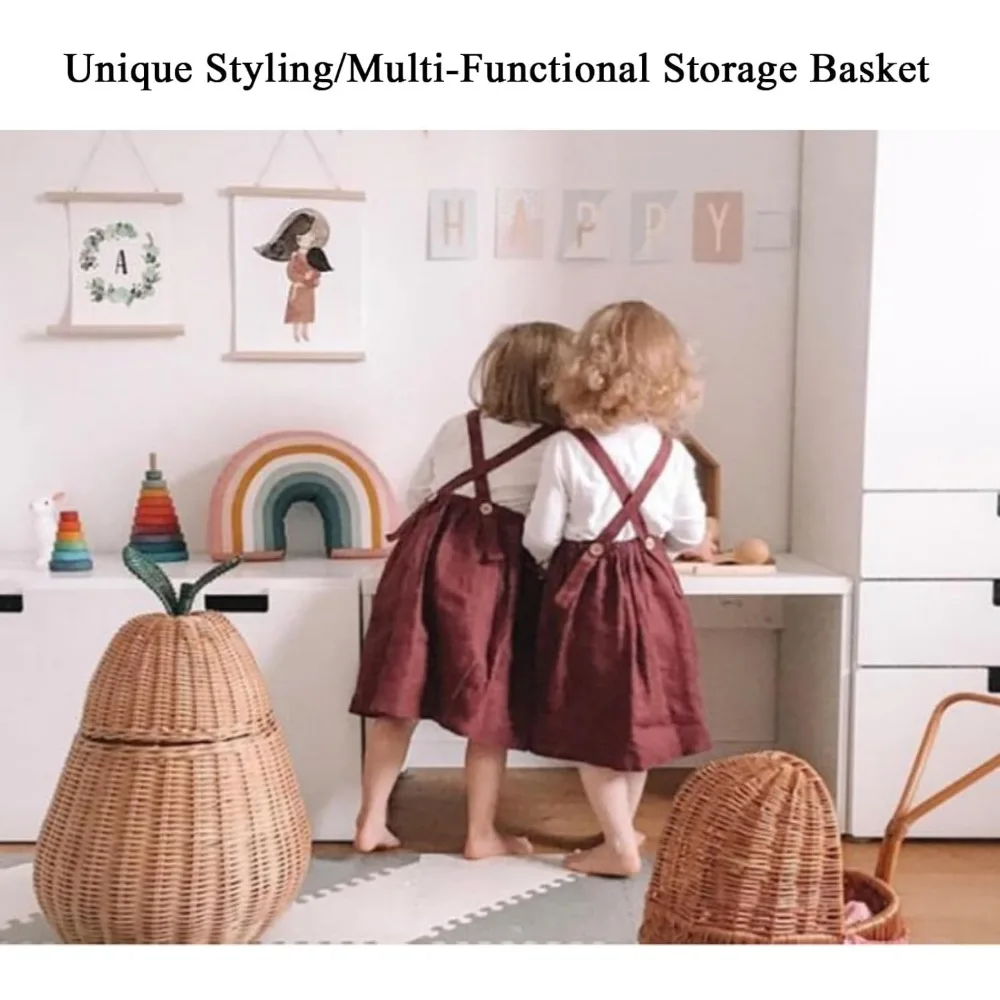
Best Practices for Basket Storage and Display
Whether your baskets are in daily use, seasonal rotation, or permanent display, proper storage and display techniques will significantly extend their lifespan and maintain their appearance.
For Baskets in Regular Use
Even everyday baskets deserve care to prevent premature wear:
- Line the bottom with fabric or paper to prevent wear on the base
- Avoid overfilling, which can strain the weave and handles
- Rotate baskets periodically to distribute wear evenly
- Use plastic or fabric liners when storing damp items
- Clean promptly after any spills or exposure to moisture
- Consider protective coatings for baskets that see heavy use
Long-Term Storage Methods
For seasonal or occasionally used baskets:
- Clean thoroughly and ensure baskets are completely dry before storage
- Store in cool, dry locations with stable temperature
- Avoid attics and basements, which often have humidity issues
- For stacking, place smaller baskets inside larger ones with acid-free tissue paper between them
- Support basket shapes with crumpled acid-free tissue inside
- Cover with cotton sheets or pillowcases to protect from dust while allowing airflow
- Check stored baskets periodically for signs of pests or mold
Display Recommendations
For baskets that serve a decorative purpose:
- Rotate displayed baskets quarterly if exposed to sunlight
- Support wall-mounted baskets properly with appropriate hardware
- Position away from direct sunlight, which causes fading
- Keep away from fireplaces, radiators, and vents
- Consider museum-style display techniques for valuable pieces
- Dust regularly with soft brush or vacuum with brush attachment
- Handle with clean hands during cleaning or rearrangement
Seasonal Storage Checklist
- ☐ Clean thoroughly before storage
- ☐ Check for and address any damage
- ☐ Ensure completely dry (minimum 24-48 hours air drying)
- ☐ Stuff with acid-free tissue to maintain shape
- ☐ Cover with breathable cotton cover
- ☐ Store in climate-controlled environment
- ☐ Label storage containers if baskets aren’t visible
- ☐ Note any special care needs for next season
Creative DIY laundry organization using wicker baskets often involves stacking or nesting baskets, making proper support crucial to maintain their shape. Tidy Treasure offers a variety of wicker storage baskets designed with proper storage features that help maintain their structure even during long periods between use.
Troubleshooting Common Basket Problems
Even with careful maintenance, baskets sometimes develop issues. Here’s how to identify and address the most common problems.
Mold and Mildew
Identification:
– White, green, or black spotting
– Musty, damp odor
– Discoloration in affected areas
– Slightly fuzzy texture on basket surface
Causes:
– Stored while damp
– High humidity environment
– Poor air circulation
– Water damage
Solution:
1. Take outdoors if possible to prevent spore spread
2. Brush away visible mold with soft brush
3. For natural fibers: mix equal parts white vinegar and water
4. Apply sparingly with cotton swab or soft brush
5. Dry thoroughly in well-ventilated area with good airflow
6. For synthetic materials: use more direct cleaning with mild soap solution
Prevention:
– Ensure baskets are completely dry before storage
– Store in well-ventilated areas with moderate humidity
– Use moisture-absorbing products nearby if needed
– Check stored baskets periodically
Fading and Discoloration
Identification:
– Uneven color, especially on one side
– Overall lightening of natural color
– Yellowing of light-colored materials
– Darkening in some areas
Causes:
– Sun exposure
– Age
– Chemical exposure
– Heat damage
Solution:
– Natural discoloration is often permanent
– For synthetic materials, gentle cleaning may help
– Some natural materials can be treated with food-safe oils to restore luster
– In severe cases, consider decorative coverings or liners
Prevention:
– Keep baskets out of direct sunlight
– Rotate displayed baskets regularly
– Use UV-filtering window treatments
– Keep away from heat sources
Brittleness, Splitting, and Cracking
Identification:
– Material breaks rather than bends
– Visible cracks or splits in the weaving
– Pieces breaking off during handling
– Audible cracking sounds when handled
Causes:
– Age
– Extremely dry conditions
– Heat exposure
– Natural material deterioration
Solution:
1. For natural materials: lightly mist with water in spray bottle
2. Place in bathroom during a shower to expose to gentle humidity
3. Once slightly more pliable, reshape if needed
4. Apply food-safe oil (like mineral oil) very sparingly to natural fibers
5. Allow to air dry completely
Prevention:
– Maintain moderate humidity (40-65%)
– Apply appropriate oils or treatments annually
– Handle gently, especially older baskets
– Store properly with shape support
Unpleasant Odors
Identification:
– Musty smell
– Persistent food odors
– Chemical smell
– Smoke odor
Solutions:
1. Air outside on dry, breezy day
2. For natural materials: mix 1 part white vinegar to 3 parts water
3. Apply lightly with spray bottle, avoiding saturation
4. For stubborn odors, place baking soda inside basket overnight
5. For synthetic materials, more thorough washing is possible
Prevention:
– Use liners for food storage baskets
– Clean promptly after spills
– Store in well-ventilated areas
– Keep away from strong-smelling items
Understanding whether wicker baskets are good for laundry storage helps prevent common issues like odor buildup and moisture damage in bathroom and laundry areas.
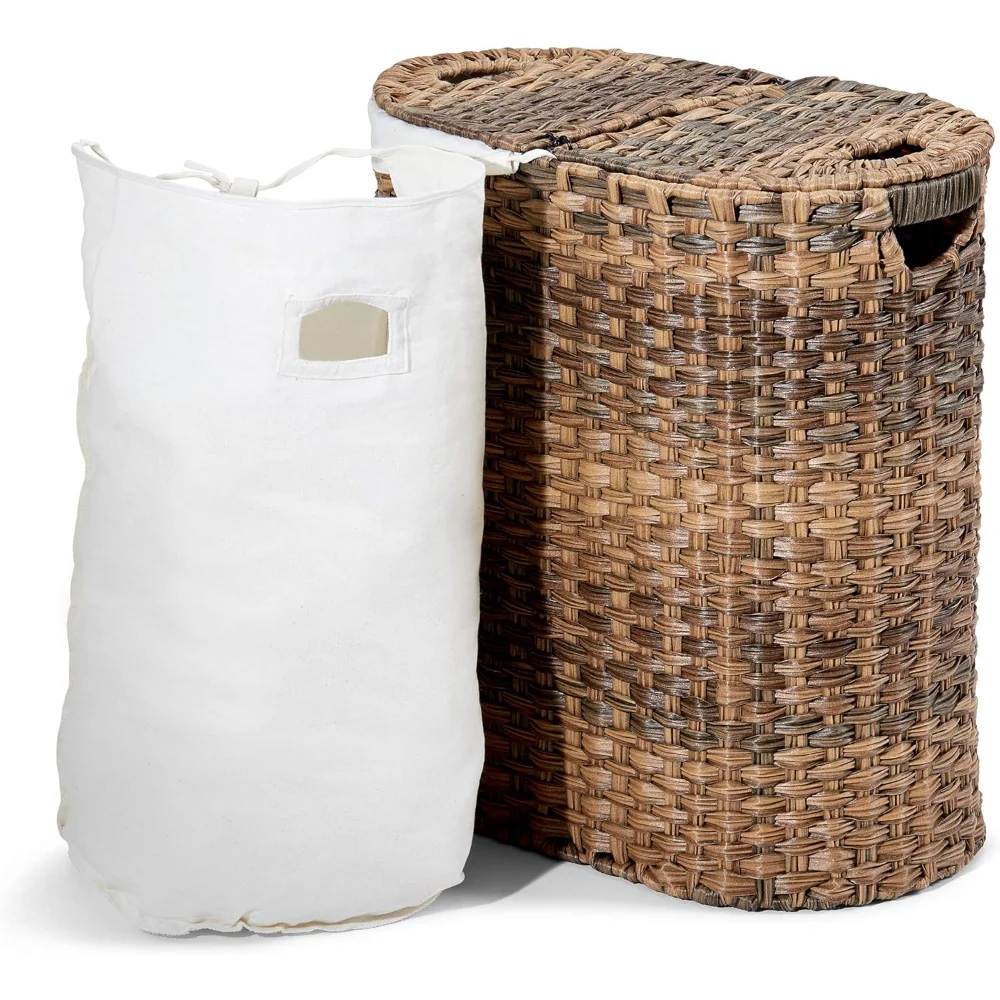
Restoration and Revitalization Techniques
With proper techniques, many damaged baskets can be restored to functional and attractive condition. These methods can extend your basket’s life significantly.
Reshaping Methods for Warped Baskets
Natural fiber baskets sometimes lose their shape due to improper storage or humidity changes. Here’s how to restore them:
Prepare the basket:
– Clean thoroughly and allow to dry
– Remove any liners or decorative elementsApply moisture carefully:
– For minor warping: mist lightly with water using spray bottle
– For significant warping: wrap in damp (not wet) towels for 30-60 minutes
– For severe warping: place in bathroom during a shower to absorb ambient moistureReshape while damp:
– Gently bend material back to desired shape
– Use your hands to press out bulges
– For flat bottoms, place on flat surface with weight on top
– For round baskets, stuff with towels to create proper shapeSet the shape:
– Allow to dry completely in desired position (24-48 hours)
– Place weights or supports as needed to maintain shape
– Turn occasionally for even drying
Caution: Never soak natural fiber baskets completely, as this can cause damage to the material and any adhesives used in construction.
Protective Coatings and Finishes
The right finish can protect and beautify your baskets:
For Natural Fiber Baskets:
– Boiled linseed oil: Provides rich color and protection, apply very thinly
– Beeswax: Creates water-resistant finish, good for baskets near water
– Food-grade mineral oil: Safe for food baskets, enhances color
– Clear shellac: Creates harder finish for frequently used pieces
Application Technique:
1. Clean basket thoroughly and allow to dry completely
2. Test product on bottom or inside of basket first
3. Apply thin layer with soft cloth, following grain of material
4. Wipe away excess immediately—less is more!
5. Allow to dry completely between coats
6. For natural oils, reapply yearly or when basket appears dry
Synthetic Basket Sealants:
– Clear acrylic sprays designed for crafts
– UV-protective clear coats
– Waterproofing sprays specifically for synthetic materials
Minor Damage Repair
Small repairs can prevent bigger problems:
Securing Loose Ends:
1. Trim any frayed fibers neatly with small scissors
2. For natural materials, dampen end slightly to make pliable
3. Tuck end back into weave using blunt toothpick or skewer
4. Secure with tiny dot of pH-neutral craft glue if needed
Fixing Small Breaks:
1. Clean break area thoroughly
2. Apply small amount of appropriate glue (wood glue for natural fibers)
3. Press broken pieces together firmly
4. Secure with clothespins or painter’s tape while drying
5. Allow to dry completely before handling (24+ hours)
Replacing Damaged Sections:
1. For minor areas, weave in similar replacement material
2. Match color and thickness as closely as possible
3. Secure ends by tucking into existing weave
4. For larger repairs, consider professional restoration
Wicker baskets used for laundry can benefit from occasional refinishing to maintain their elegant appearance. Understanding basket weaving techniques can be invaluable when attempting repairs, as it helps you follow the original construction pattern.
Specialized Care for Functional Baskets
Baskets serving specific functions have unique care requirements beyond general maintenance. Here’s how to care for baskets based on their primary use.
Food Storage and Serving Basket Care
Baskets that hold food require extra attention to hygiene:
- Food-Safe Liners:
- Use removable, washable cloth liners
- Consider food-grade plastic liners for moist foods
- Replace liners if they become stained or odorous
Wash liners frequently in hot water
Cleaning Guidelines:
- Clean immediately after any food contact
- Pay special attention to crevices where crumbs collect
- Use food-safe cleaning solutions (vinegar/water solution is ideal)
Dry thoroughly before storing or reusing
Safe Treatments:
- Only use food-safe oils like mineral oil or beeswax
- Never use chemical sealants on food baskets
- Apply treatments to exterior only for bread baskets
- Allow treatments to fully cure before using with food
Planter Basket Maintenance
Baskets used for plants face moisture challenges:
- Waterproofing Options:
- Use plastic liners with drainage holes
- Apply multiple layers of natural beeswax to interior
- Consider plastic pot inserts that fit inside basket
For outdoor planters, use UV-resistant waterproof liners
Drainage Considerations:
- Ensure water doesn’t pool in bottom of basket
- Elevate pots inside baskets with “feet” or stones
- Check regularly for water damage to basket bottom
Consider adding protective bottom layer for extra durability
Between-Plant Care:
- Clean thoroughly when changing plants
- Allow to dry completely before adding new plants
- Check for and address any mold or mildew
- Apply fresh waterproofing if needed
Laundry Basket Care
Laundry baskets require special attention to handle moisture and lint:
- Liner Options:
- Use washable fabric liners for damp clothes
- Consider moisture-resistant liners for bathroom use
Wash liners regularly to prevent odor buildup
Ventilation Needs:
- Choose open-weave designs for air circulation
- Avoid storing damp items for extended periods
- Allow basket to air out between uses
Store in well-ventilated areas
Cleaning for Lint Prevention:
- Vacuum weekly with brush attachment
- Wipe down with damp microfiber cloth to collect lint
- For synthetic baskets, occasional washing helps remove embedded lint
- Consider lint roller for quick touch-ups
Black Wicker Baskets, Rattan Storage Baskets, Tall Wicker Baskets, Wicker Shelf Baskets, Woven Storage Baskets
5-Tier Distressed Black Wood Frame Storage Tower with Removable Wicker Baskets for Home Organization$715.80 Select options This product has multiple variants. The options may be chosen on the product pageWicker Laundry Baskets, Woven Laundry Baskets, Woven Storage Baskets
$392.02 Select options This product has multiple variants. The options may be chosen on the product pageRattan Shelf Baskets, Rattan Storage Baskets, Small Wicker Baskets, Square Wicker Baskets
Square Plastic Wicker Storage Baskets Set of 3 with Collapsible Design for Cube Storage Organization$185.47 Select options This product has multiple variants. The options may be chosen on the product pageWicker Baskets with Handles, Wicker Storage Baskets, Woven Storage Baskets
$137.92 Select options This product has multiple variants. The options may be chosen on the product pageLarge Wicker Laundry Baskets, Tall Wicker Baskets, Woven Laundry Hampers, Woven Storage Baskets
$130.54 Select options This product has multiple variants. The options may be chosen on the product pageWoven Laundry Baskets, Woven Laundry Washing Baskets
Price range: $136.76 through $581.37 Select options This product has multiple variants. The options may be chosen on the product page
Transforming your home with wicker laundry baskets combines both style and function when baskets are properly maintained. For outdoor use, wicker picnic baskets require additional protection against sun exposure and moisture to maintain their appeal.

Preserving Heirloom and Collectible Baskets
Heirloom and collectible baskets often have both monetary and sentimental value that makes their preservation particularly important. These special pieces require a different approach than everyday baskets.
Preservation vs. Restoration Philosophy
When dealing with valuable baskets, consider:
- Preservation aims to prevent further deterioration while maintaining historical integrity
- Restoration attempts to return an item to previous condition, potentially decreasing value
- For truly valuable pieces, preservation is often preferred over aggressive restoration
- Document the basket’s condition before any intervention
- Consider consulting with a conservation professional for valuable antiques
Environmental Control Importance
For valuable baskets, environment is critical:
- Maintain consistent temperature (65-70°F/18-21°C ideal)
- Control humidity levels (45-55% relative humidity)
- Install UV-filtering window treatments in display areas
- Consider microenvironments (display cases with humidity control)
- Monitor conditions with inexpensive humidity/temperature gauges
- Keep away from exterior walls which may have temperature fluctuations
Proper Support and Handling
Handling techniques for valuable pieces:
- Always wear clean cotton gloves when handling significant pieces
- Support from underneath rather than gripping sides or handles
- Use padded surfaces when setting baskets down
- Create custom supports from acid-free materials for display
- Limit handling to minimum necessary
- Never stack valuable pieces
Documentation Practices
For serious collectors:
- Photograph baskets from multiple angles
- Record measurements, materials, and construction techniques
- Note any maker’s marks or distinctive features
- Keep information on provenance and history
- Update documentation if condition changes
- Store information separately from baskets as emergency backup
Special care should be taken with top-rated wicker baskets for sorting laundry that you hope to preserve for long-term use, as their frequent handling requires particular attention to structural support.
Special Considerations for Seasonal and Holiday Baskets
Baskets used for seasonal décor or holiday gatherings face unique challenges since they’re typically used intensively for short periods, then stored for months. This usage pattern requires special care.
Storage Needs for Seasonal/Holiday Baskets
Proper storage between uses is crucial:
- Clean thoroughly before storage to prevent stain setting and pest attraction
- Ensure baskets are completely dry (minimum 48 hours air-drying)
- Store in climate-controlled areas, not attics or basements if possible
- Use acid-free tissue to support shapes during long storage
- Cover with cotton pillowcases or sheets rather than plastic
- Label storage containers for easy identification next season
- Store flat-bottomed baskets upright, not on their sides
Pre-Season Preparation Guidelines
Before bringing seasonal baskets back into use:
- Inspect for any damage that occurred during storage
- Gently brush or vacuum to remove dust
- Air out in well-ventilated area for 24-48 hours
- Check for and address any musty odors
- Reshape if minor distortion has occurred
- Apply appropriate conditioning treatments if materials appear dry
- Replace any damaged liners before use
Post-Season Cleaning and Preparation
After seasonal use, prepare baskets properly for storage:
- Remove all contents completely
- Check for and clean any spills or stains
- Address any damage that occurred during use
- Allow to fully air dry in well-ventilated area
- Apply conditioning treatments if needed
- Prepare storage supports using acid-free tissue
- Store in climate-controlled environment
Seasonal Care Calendar
| Season | Care Tasks |
|---|---|
| Spring | Air out winter-stored baskets; condition dry materials; check for mold after winter storage |
| Summer | Protect from direct sunlight; monitor for insect activity; check outdoor baskets frequently |
| Fall | Clean harvest/garden baskets thoroughly; prepare holiday baskets for use |
| Winter | Maintain humidity for baskets in heated homes; prepare spring/summer baskets for storage |
Decorative wicker baskets for laundry organization often double as seasonal décor and therefore benefit from this careful rotation and storage approach.

FAQ: Your Basket Care Questions Answered
How often should I clean my baskets?
For baskets in regular use, dust weekly and inspect monthly for deeper cleaning needs. Display-only baskets should be dusted bi-weekly. Baskets in high-traffic or high-humidity areas need more frequent attention. Always clean immediately after spills or visible soiling.
Is it safe to use water on wicker baskets?
This depends entirely on the material. Synthetic wicker can generally handle water exposure, while natural materials require caution. Use minimal moisture on natural materials, never submerge them, and ensure complete drying. Some sealed baskets can handle light wiping with damp cloths, but always test in an inconspicuous area first.
What’s the best way to remove mold from a basket?
Take the basket outdoors to prevent spore spread indoors. Brush away visible mold with a soft brush. For natural materials, apply a solution of equal parts white vinegar and water with a cotton swab, then dry thoroughly in a well-ventilated area. For severe cases or valuable baskets, consult a professional conservator.
How can I prevent my natural fiber baskets from becoming brittle?
Maintain moderate humidity (40-65%) where baskets are kept. Apply appropriate conditioning treatments yearly—food-grade mineral oil or beeswax for many natural fibers. Keep away from heat sources and direct sunlight. For baskets in very dry environments, consider using a room humidifier.
Can I paint or decorate my baskets?
Yes, but preparation is crucial. Clean and dry completely first. For natural materials, apply a primer designed for porous surfaces. Use paints specifically formulated for the basket material (acrylic works well for most). Apply multiple thin coats rather than one thick layer. Finish with appropriate sealer to protect your design.
How do I eliminate persistent odors from baskets?
First, air baskets outside on a dry, sunny day. For natural materials, wipe with a cloth barely dampened with equal parts water and white vinegar, then dry thoroughly. Alternatively, fill the basket with crumpled newspaper for 24-48 hours, replacing if necessary. Baking soda left inside overnight also absorbs odors effectively.
How can I prevent insect infestations in my baskets?
Regular cleaning is your first defense. Store with cedar blocks or lavender sachets, which naturally repel many insects. Periodically inspect stored baskets for signs of infestation. For valuable collections, consider periodic freezing (48 hours at 0°F/-18°C) to kill any eggs or larvae, but research proper techniques for your specific basket type first.
Rattan storage baskets with proper care maintain their structural integrity even in challenging environments like bathrooms or kitchens.
Is Professional Restoration Worth the Investment?
Deciding whether to invest in professional basket restoration depends on several important factors. Consider these guidelines when making your decision:
When DIY is Appropriate vs. Professional Services
DIY restoration is generally suitable for:
– Baskets with minor cosmetic damage
– Non-valuable everyday use items
– Simple structural issues like minor warping
– Basic cleaning and conditioning needs
Professional restoration is worth considering for:
– Family heirlooms with sentimental value
– Antique or collectible baskets with monetary value
– Complex structural damage
– Baskets with unique or rare construction techniques
– Significant mold or pest damage requiring specialized treatment
Cost-Benefit Considerations
When evaluating professional restoration:
– Get multiple estimates from qualified restorers
– Compare restoration cost to replacement value
– Consider the basket’s sentimental value beyond monetary worth
– Ask about guarantees or warranties on restoration work
– Request detailed information about proposed restoration methods
– Consider future appreciation potential for antique pieces
The investment in professional restoration typically ranges from $50-$300+ depending on the basket’s size, condition, and significance. For valuable antiques, proper restoration can actually increase value beyond the restoration cost.
Finding Qualified Basket Restorers
Look for professionals who:
– Specialize specifically in basket restoration
– Have verifiable experience with your basket type
– Can provide references or examples of previous work
– Are affiliated with museums or conservation organizations
– Offer detailed written estimates and treatment plans
– Are willing to discuss their methods and materials
For maintaining baskets used for organizing laundry, professional restoration is rarely needed if regular maintenance is performed.
Can You Revive a Severely Damaged Basket?
Even baskets with significant damage can sometimes be salvaged, though results vary based on damage type and basket construction.
Realistic Expectations
Before attempting revival of severely damaged baskets:
– Understand that perfect restoration to original condition is rarely possible
– Accept that structural integrity may be compromised even after repair
– Recognize that some repairs will be visible
– Consider the basket’s intended use after repair (display vs. functional)
– Document the current condition with photographs before beginning
Assessment Criteria
Evaluate revival potential by examining:
– Percentage of original material remaining intact
– Structural stability of remaining portions
– Type of damage (water, mold, physical breakage)
– Material type and condition (brittle vs. flexible)
– Presence of original construction elements that can guide repair
Common Severe Damage Scenarios
Water Damage Revival:
A rattan picnic basket left in damp conditions developed extensive mold and warping. After careful cleaning with vinegar solution, gradual reshaping with moisture control, and application of protective oil, it was successfully revived as a decorative piece, though no longer food-safe.
Physical Breakage Success:
A family heirloom basket with a completely detached handle and broken rim was carefully repaired by weaving in new supporting materials and securing with appropriate adhesive. While visibly repaired, it now serves as a valued display piece.
Pest Damage Transformation:
A storage basket with extensive insect damage was partially restored by removing damaged sections and reweaving with similar materials. Though smaller than the original, it found new purpose as a decorative planter.
Creative Repurposing Options
When full restoration isn’t viable:
– Convert bottom sections of damaged tall baskets into trays
– Use intact decorative elements as wall art
– Transform damaged round baskets into wreaths
– Create mosaic art from basket fragments
– Display particularly interesting damaged pieces as sculptural objects
Rattan laundry baskets with damaged handles can often be revived by focusing on reinforcing the base and sides, even if the original handle cannot be fully restored.

Proper basket care might seem time-consuming, but these beautiful, functional items deserve the attention. With regular maintenance using the techniques outlined in this guide, your baskets from Tidy Treasure will continue to bring both beauty and organization to your home for many years to come.
Remember that prevention is always easier than restoration. By implementing these care practices from the moment you bring a new basket home, you’ll ensure its lasting beauty and functionality throughout its lifetime. Your woven treasures can truly become family heirlooms with the right attention and care.

